Overview of Workplace Accident Statistics in Odessa, Texas
Odessa, a vital part of the Permian Basin in conjunction with Midland, is a hub for oil and gas extraction, refining, and service support. While Odessa has opened new opportunities for the economy, it has also introduced additional risks of workplace accidents. Industries such as drilling, fracking, trucking, and equipment maintenance are prevalent, leading to risks associated with heavy machinery, hazardous chemicals, and high-traffic rural roads. Data sources include the U.S. Bureau of Labor Statistics (BLS), the Occupational Safety and Health Administration (OSHA), the Centers for Disease Control and Prevention (CDC), and the Texas Department of Insurance (TDI). The data for 2024 is preliminary as of October 8, 2025, while the data for 2025 are incomplete at this time due to delays in reporting. This summary will focus on trends over the 2022-2024 period, asking stakeholders to situate these trends in the Permian Basin context to achieve Odessa-centred insights as Ector County stakeholders.
Key Takeaways from Recent Workplace Accident Data (2022–2024)
- Worker Fatalities: Texas recorded 826 workplace fatalities in 2024 (preliminary), down from 928 in 2023. Odessa-Ector County saw at least 8–10 deaths annually, primarily oilfield-related; the Permian Basin accounted for 31.5% of U.S. oil/gas deaths (2014–2019), with vehicle incidents causing 26.8%.
- Severe Injuries: Permian oilfield severe injuries rose ~10–15% since 2022, with Odessa contributing significantly; statewide, Texas led with 1,134 oil/gas severe cases (2015–2022), including crushes and burns.
- Nonfatal Injuries and Illnesses: Texas reported 2.6 million nonfatal cases in 2023 (down 8.4% from 2022), at 2.4 per 100 workers. Oil/gas support in Odessa exceeds this at ~148.9 per 100,000 (persistent trends), with more than 400 cases in Ector County.
- Top Contributing Factors: Vehicle crashes (26.8% of oilfield deaths), contact with equipment (21.7%), explosions/fires (14.5%), and falls (10%). Long shifts, H2S exposure, and road congestion on "Death Highway" US-285 amplify dangers.
- Regional Impact: Despite producing 40% of the nation's oil, the Permian Basin has seen a disproportionate number of fatalities; in 2023, Ector County recorded over 350 nonfatal injuries, with drilling and trucking being the leading causes.
Worker Fatalities in Odessa Workplaces
Oilfield operations in Odessa are responsible for a significant number of worker fatalities. Due to oilfield activities, transportation along US-285 is exceptionally challenging. According to preliminary data, Texas has the highest number of worker fatalities in the US, with 826 documented in 2024.
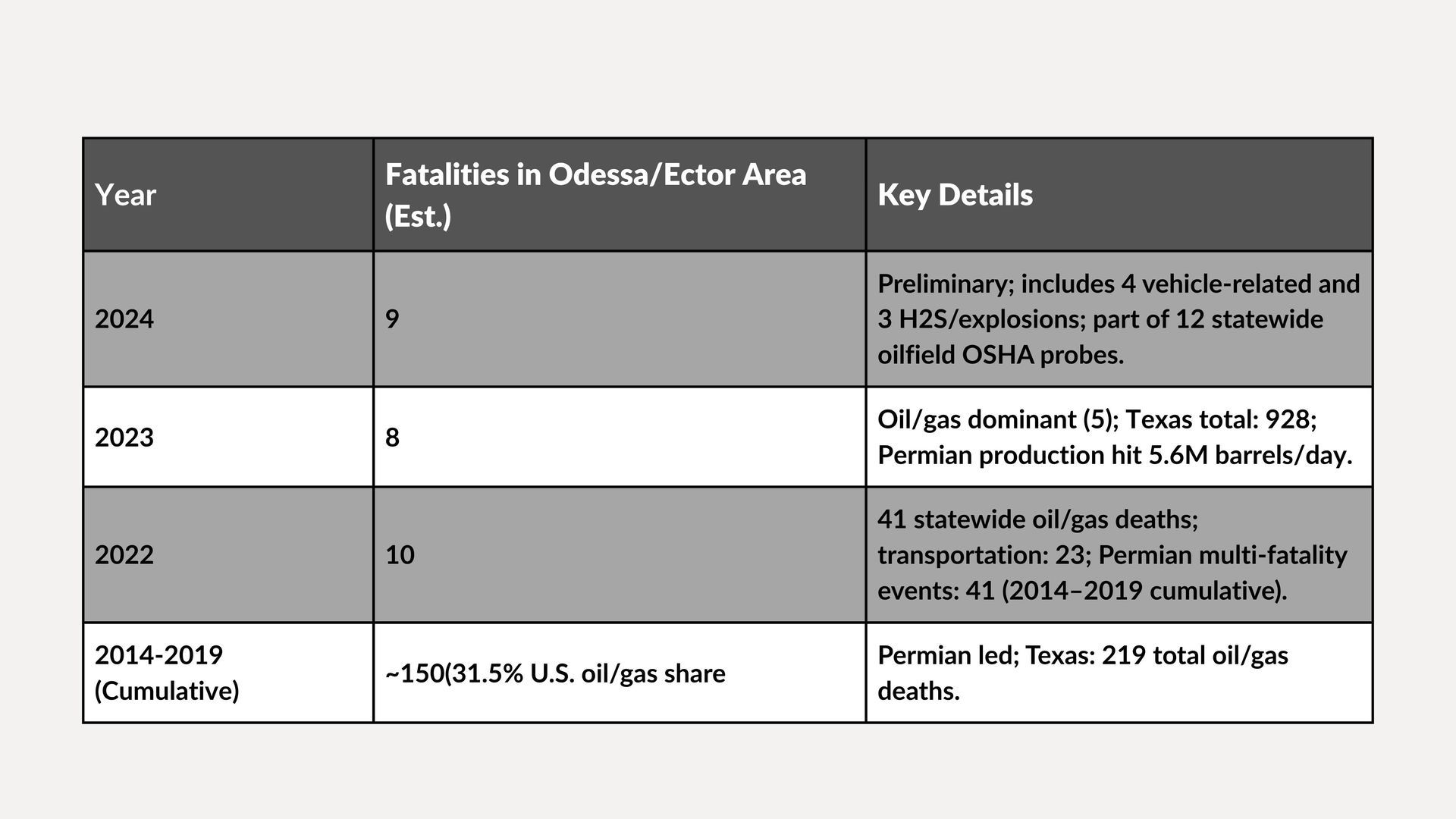
Fatalities in Odessa’s oil industry often involve subcontracted crews, underscoring the safety risks faced by outsourced workers. Between 2008 and 2017, a total of 1,566 oil and gas workers died nationwide, a number comparable to the U.S. troop losses in Afghanistan during the same period.
Severe Injuries in Odessa Workplaces
Severe injuries (amputations, hospitalizations, eye loss) via OSHA reports show well-servicing at 70% of cases. Odessa's rise is linked to ~500 active rigs and increased hauls.
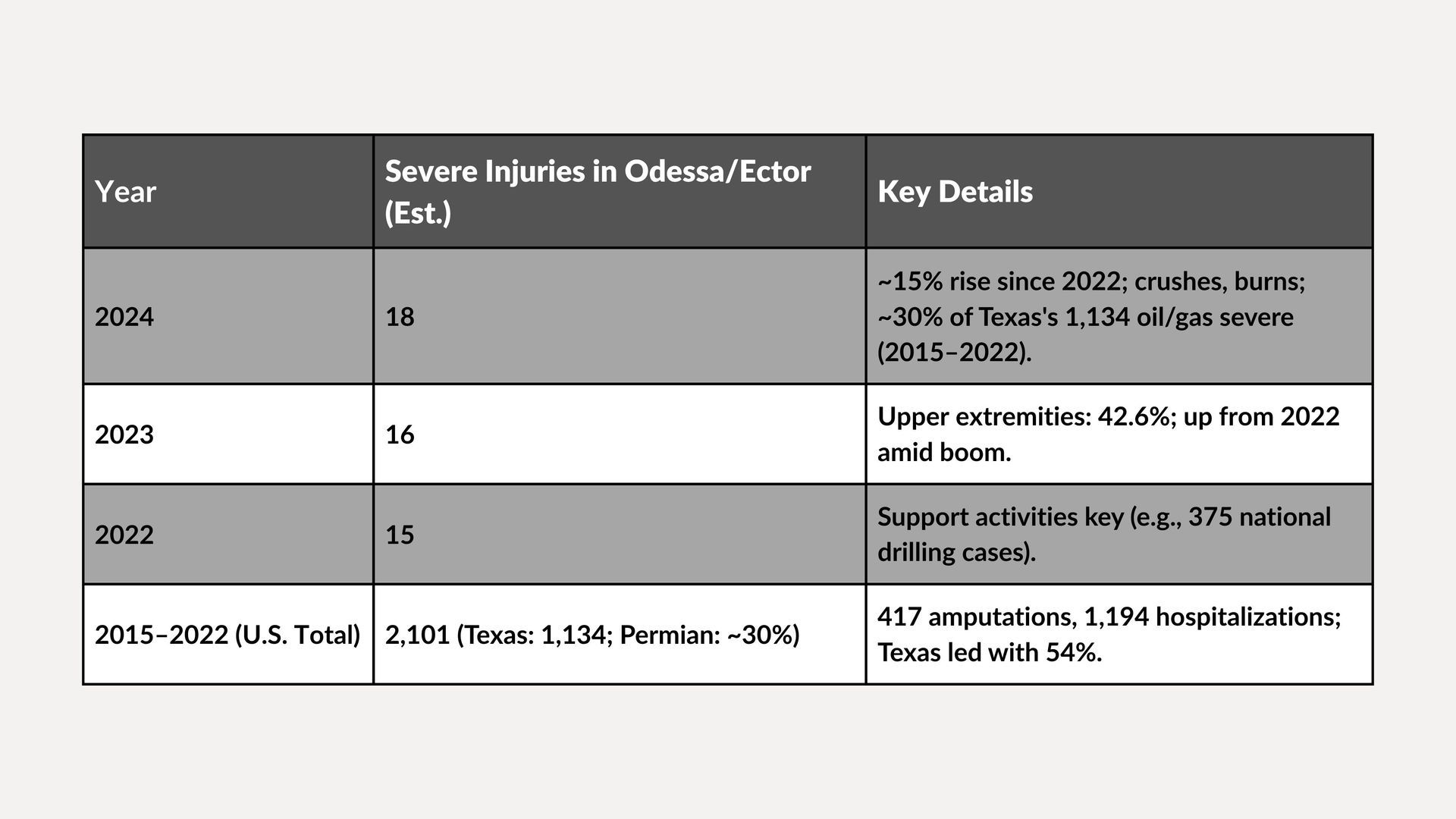
According to the Bureau of Labor Statistics, the fatality rate in the oil and gas sector was 1.5 per 100 employees in 2023. Crush occurrences involving the upper extremities accounted for 42.6% of all reported injuries.
Nonfatal Injuries and Illnesses in Odessa Workplaces
BLS data indicate that Texas's private industry had 2.4 cases per 100 workers in 2023. Odessa's oil support rates remain elevated at 148.9 per 100,000.
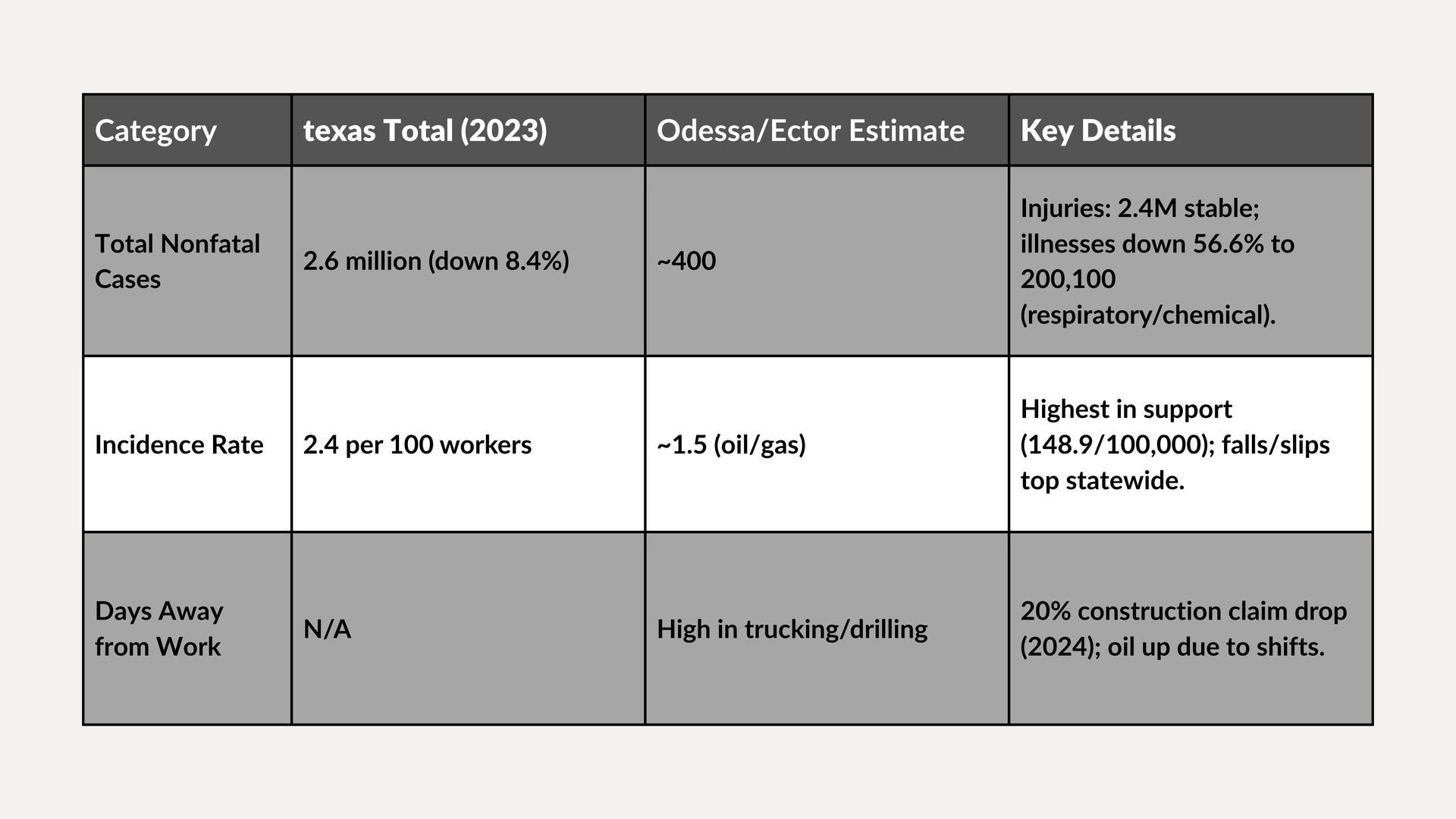
Vehicle and Transportation Accidents in Odessa Workplaces
Vehicle crashes are the leading cause of death in the oilfield (26.8%), with US-285 being particularly overwhelmed by hauls. TxDOT reported ~1,000 truck accidents in the Odessa area in 2023.
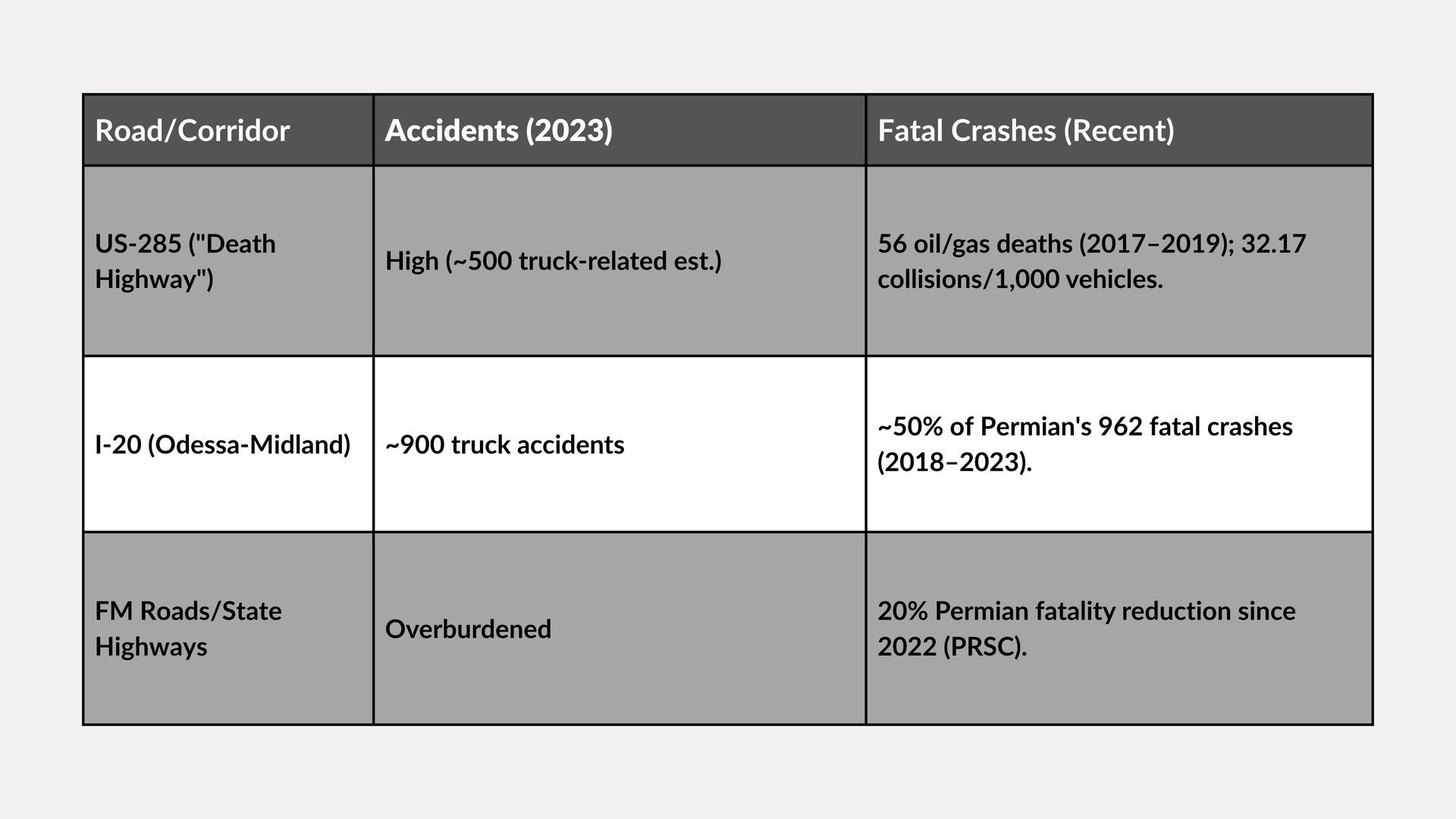
Long 14-hour shifts, worker fatigue, and poorly maintained roads are major contributing factors to accidents in the oil industry. In fact, 41% of Texas oil-related deaths in 2022 were transportation-related.
Notable Workplace Incidents in the Odessa Area
Recent events have highlighted the perils of the oilfield, with OSHA investigations into H2S and explosions.
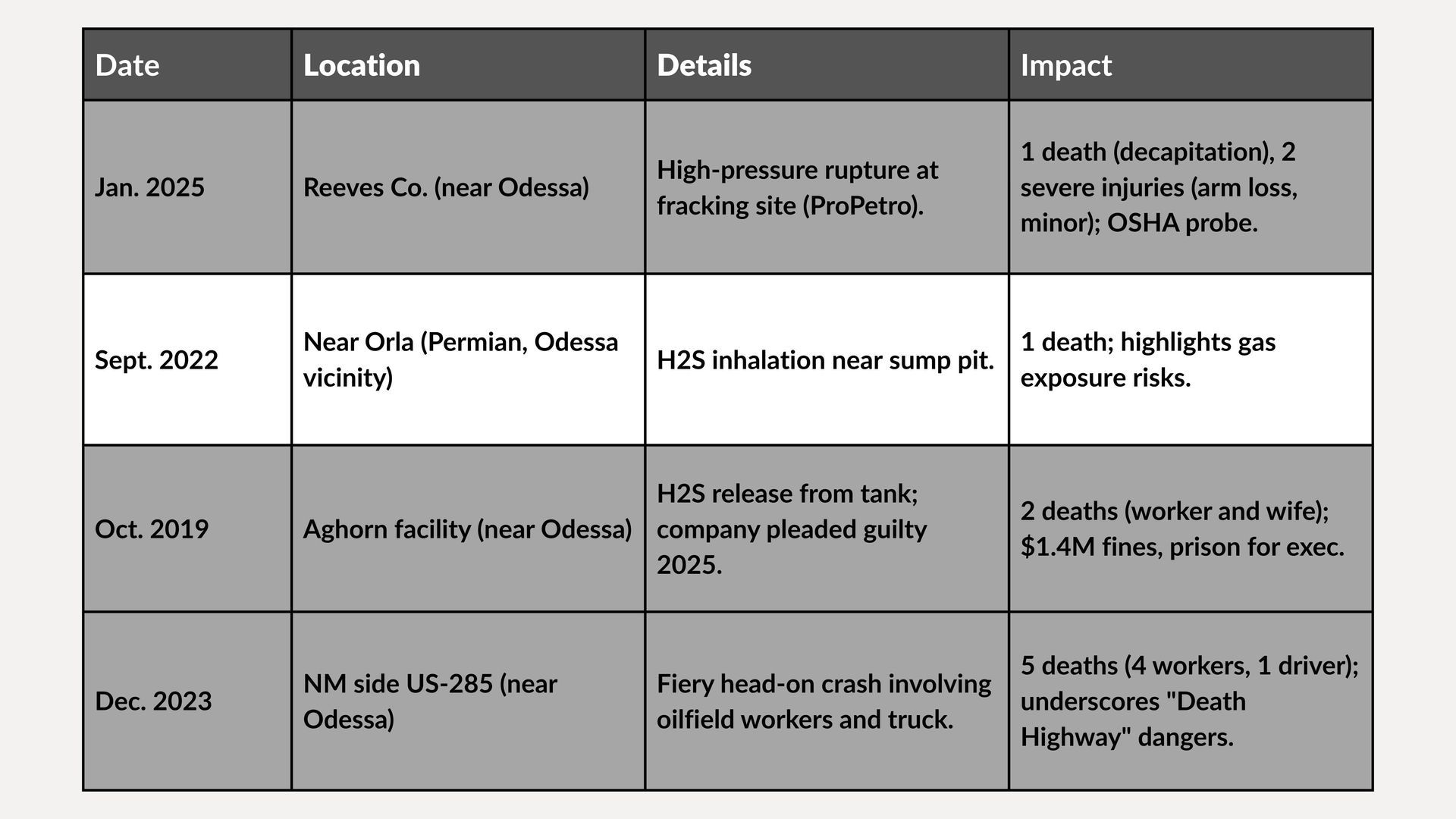
Since 2022, the Railroad Commission of Texas has recorded over 100 crude oil spills across the state. In 2024, OSHA cited 316 violations in the Permian Basin alone and issued $1.4 million in penalties.
Broader Context and Trends
- Production vs. Safety: In 2023, Texas produced 1.92 billion barrels of oil (42% of U.S.-mentioned production), while fatalities in the Permian Basin doubled from 2021 to 2022. These developments are pushing Odessa to boom (~4 million barrels per day), taxing the current infrastructure.
- Regulatory Notes: OSHA's Permian STEPS promotes training; Texas is #1 in fatalities, but there has been a 13% drop in severe injuries statewide (2024); critics cite underreporting.
- Limitations: BLS excludes self-employed individuals and public sector employees, focusing upstream. Raw data: BLS IIF, OSHA Fatality Inspection.
A2X Law: Your Advocate for Workplace Safety and Justice
The Odessa oil and gas industry is among the most dangerous workplaces in the world. Therefore, workers and their families must maintain vigilant safety practices and have access to legal services to protect their rights under the law. A2X Law represents workplace accident victims and their families through the workers' compensation process, personal injury, and wrongful death claims. They understand that the challenges of the Permian Basin are unique. Therefore, they are dedicated to fighting for fair compensation and accountability, ensuring justice for the injured worker or the family of the deceased worker. If you, or a family member, have experienced an accident on the job, reach out to A2X Law to evaluate your legal options and support for you and your family.
Request a Consultation
Other Practice Areas







